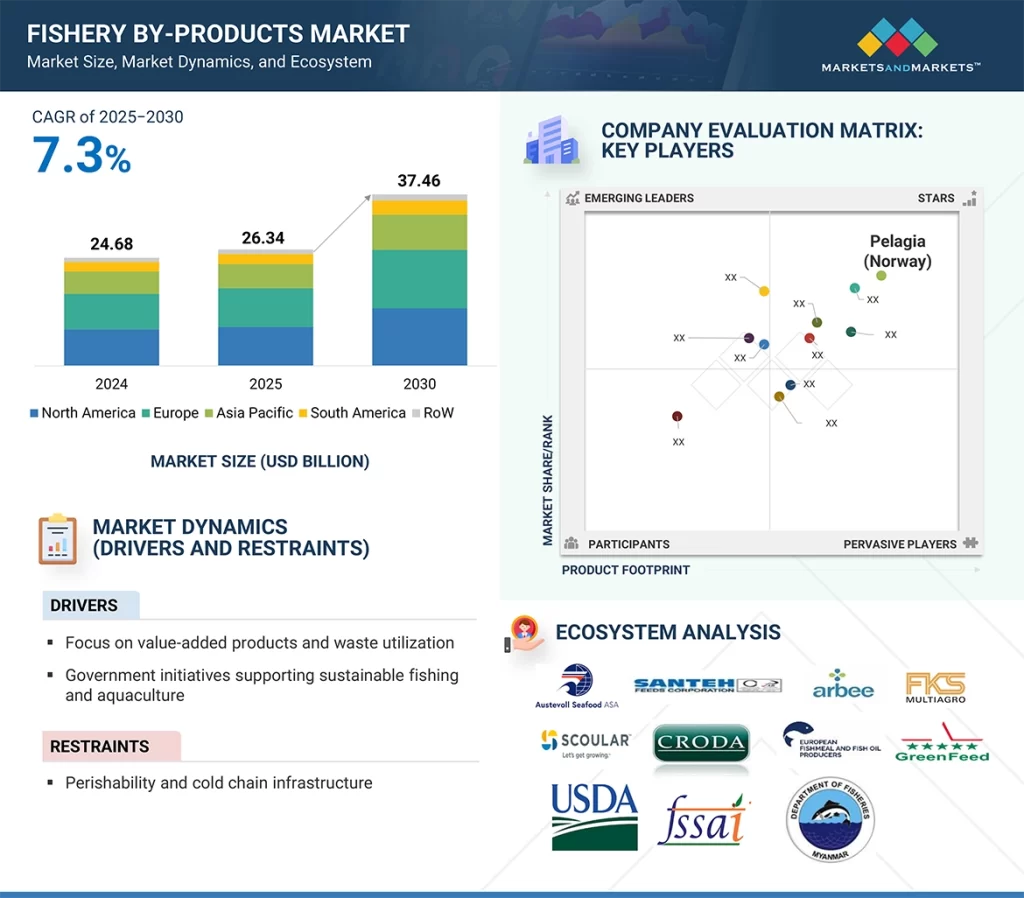The fishery by-products market is on a strong growth trajectory, estimated at USD 26.34 billion in 2025 and projected to reach USD 37.46 billion by 2030, growing at a CAGR of 7.3%. What was once considered low-value waste is now becoming a critical resource across industries—most notably in animal feed, pharmaceuticals, food, and cosmetics.

Driving Growth: Aquaculture and Animal Nutrition
One of the largest applications of fishery by-products is in the animal feed sector, especially aquaculture. Fishmeal and fish oil remain essential ingredients thanks to their high protein content and abundance of omega-3 fatty acids (EPA and DHA).
As global seafood demand rises, the aquaculture industry continues to expand, increasing the need for sustainable and cost-effective feed inputs. Instead of relying on whole wild-caught fish, processors are now turning trimmings, viscera, and other by-products into valuable inputs—reducing ecological pressure on marine ecosystems.
Download PDF Brochure: https://www.marketsandmarkets.com/pdfdownloadNew.asp?id=215268677
From Waste to Valuable Ingredients
Marine and inland capture fisheries generate vast amounts of by-products—heads, skins, bones, frames, and viscera—often accounting for 30–50% of the total catch by weight. Traditionally discarded, these materials now form the backbone of fishmeal and fish oil production.
According to the Marine Ingredients Organization, over 17 million tonnes of wild-caught fish are processed annually into fishmeal and fish oil. A key contributor is the Peruvian anchovy (Engraulis ringens), prized for its high oil and protein content and serving as one of the world’s largest sources of fishmeal.
In 2018, global production reached an estimated 5.6 million tonnes of fishmeal and 1.6 million tonnes of fish oil, with 65.8% of processing waste coming from capture fisheries.
Beyond fishmeal and fish oil, by-products are also being used to extract chitin and chitosan from crustacean shells (used in pharmaceuticals, cosmetics, and biodegradable materials), as well as collagen and gelatin from fish skins and bones, which are gaining popularity in both food and biomedical applications.
End-User Industries: Feed Leads the Way
The animal feed industry remains the largest consumer of fishery by-products. Fishmeal and fish oil are particularly important for aquaculture, poultry, and swine feed.
- Aquaculture: Fishmeal is indispensable in salmon diets due to its digestibility and nutrient density. Rapid aquaculture growth in regions such as Asia-Pacific and South America is expected to drive demand further.
- Poultry & Swine: Fishmeal is used in starter feeds and breeding stock formulations where protein efficiency is critical.
Sustainability push: Rising fishmeal prices and sustainability concerns are encouraging greater use of fishery by-products as substitutes for whole fish.
Leading Fishery By-products Companies:
The global fishery by-products market is dominated by established companies with strong global footprints, including:
- TripleNine Group (US)
- FF Skagen A/S (Denmark)
- Pesquera Diamante Peru (Peru)
- Oceana Group Limited (South Africa)
- Scoular Company (US)
- Austevoll Seafood ASA (Norway)
- Maruha Nichiro Corporation (Japan)
- Nippon Suisan Kais (Japan)
- Sopropêche (France)
- Thai Union Ingredients (Thailand)
These players leverage R&D capabilities, product innovations, partnerships, and global distribution networks to strengthen their market presence. With growing demand across animal feed, pharmaceuticals, and sustainable materials, the market is ripe for innovation and expansion.
